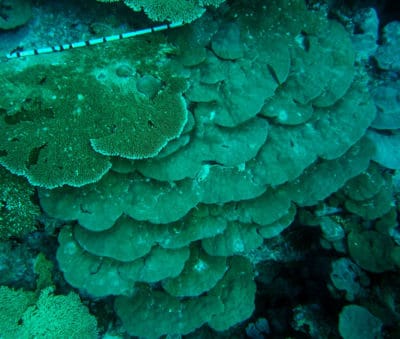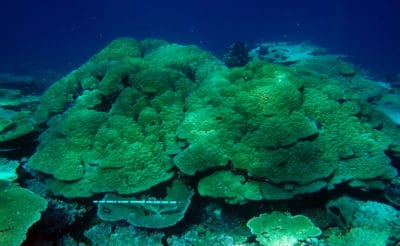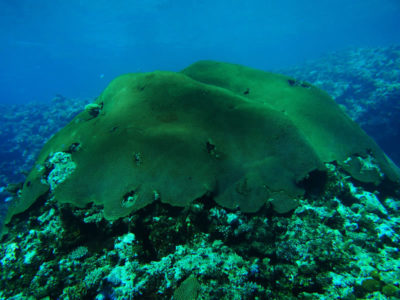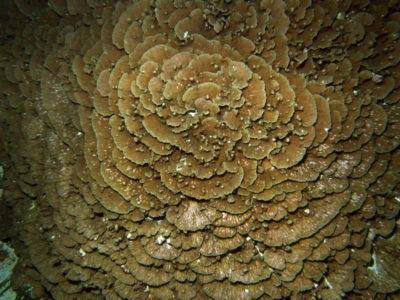Expedition Log: BIOT – Day 25
Before starting a research mission in a new area, I compile lists of all the species of corals and fishes that are known to occur in an area. For some areas, such as BIOT, the lists are incomplete because so little research has been done there. Species distributions are often determined from field observations, studies, photographs and specimens collected and maps are then created showing the general region occupied by that coral. Often, the range of a species may be much greater and future studies may show range extensions. Concurrently, a species may be absent from a specific location within its distributional range. This may be due to the rarity of a species, some type of geographic barrier or other factors. In some cases, a species may also become locally extinct, or extirpated from an area due to catastrophic mortality.
In BIOT, we frequently saw one coral, the Chagos brain coral (Ctenella chagius) with a very restricted range. It is absent from everywhere in the Pacific and Indian Ocean except for the Chagos Archipelago.

Chagos brain coral, Ctenella chagius.
There were several corals which were exceedingly common in other locations we examined during the Global Reef Expedition, but rare at Chagos. We also noticed some dramatic differences between the first and the second missions.
One of the corals we searched for extensively during our first mission to BIOT was one of the most important frame builders of Indo-Pacific reefs, large massive Porites colonies (Porites lutea and Porites lobata). We partnered with a team of researchers from Woods Hole Oceanographic Institute who needed to take particularly large (2-3 m) cores from these species to reconstruct patterns of climate change over the past centuries. After weeks of searching, they failed to find a single large hemispherical colony on BIOTs southern reefs. Most colonies were small, formed thick plates or overlapping shingles, and they were often extensively bioeroded. Yet when we returned to examine the northern atolls, this coral was unusually common, and colonies of 3-4 m diameter and several meters in height were common. One explanation for the differences may be related to the 1998 bleaching event. During this event, unusually high sea water temperatures and bleaching impacts were observed much deeper in the south (to 35 m), while northern reefs were much less affected below 12-15 m.


Porites lutea shingles (scale bar is 1 m) to the left, and hemispherical Porites lutea over 4 m diameter to the right.
(click-thru on images for greater detail)
Another oddity was a large massive coral known as the honeycomb coral (Diploastrea heliopora). This conspicuous coral forms robust, dome-shaped colonies that can achieve sizes up to 3-4 m tall and wide. It is reported from BIOT, yet we never observed a single colony in the 125 different sites we examined. In other areas, this coral appears to be resistant to most stressors. It can survive a major cyclone with minimal damage, it is often resistant to crown-of-thorns starfish predation, and it is susceptible to few diseases. This coral may well represent one of the first corals to have been extirpated from BIOT, possibly due to the 1998 bleaching event.

Honeycomb coral, Diploastrea heliopora, photographed here at Fiji yet conspicuously missing at BIOT.
Other inconspicuous corals included the needle corals (Seriatopora); colonies never formed large thickets and they appeared to be restricted to a few lagoonal areas. Many other corals, such as lettuce or ruffled coral (Merulina spp.), bubble coral (Plerogyra), button coral (Cynarina), trumpet coral (Caulastrea), anchor and hammer corals (Euphyllia), elegance coral (Catalaphyllia) and open brain coral (Trachyphyllia), were either absent or observed infrequently. Several of these are rare species, or restricted to specific habitats, so it is possible that we never surveyed these habitats.


Catalaphyllia jardinei (left) from the Great Barrier Reef, and Merulina scabricula (right) from Palau – neither found at BIOT.
(click-thru on images for greater detail)
Photos: 1 Ken Marks, 2-6 Andrew Bruckner.